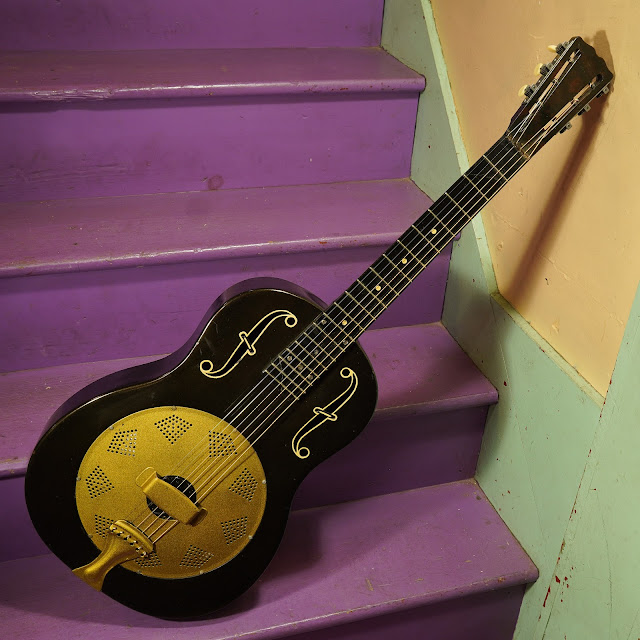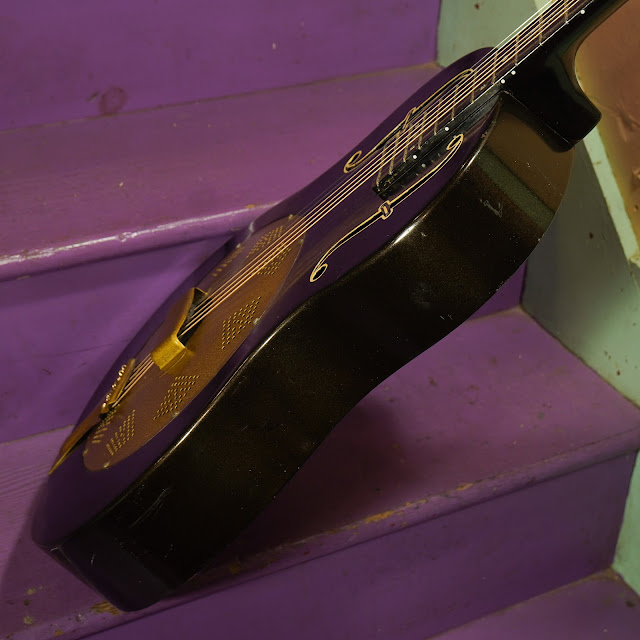This cool beast is owned by my buddy Mike Brown (a lefty) and he had me get it going for him. It's a refinished (in the body) 1929 National Triolian and features "the cursed bakelite neck" in a splotchy brown/dark red pattern. I love that whoever repainted the body used a "hammered" gold finish on the coverplate and tailpiece, a metallic deep brown for the body, and then hand-painted f-holes highlights. It's just dang cool.
Work was somewhat intensive -- I reset the neck angle, straightened-out the funky neck (via realigning the fretboard extension at the body and then scraping the fretboard down in the nut/fret 1 position), gave it a level/dress of the frets, tidied-up and reinforced the insides, and installed a K&K pickup for him with a jack out the side. What started as a bit of a trainwreck in terms of playability ended-up as a perfectly-playable, ready-to-gig-with guitar.
Luckily, this has the "version 2" bakelite neck and features an integral steel rod inside its molded exterior. This is the only reason it was really a viable project as the steel rod does take-on most of the string tension, though it did get a hair of relief in first position when strung-up at first.
Ready to see some neck photos from when I was adjusting the internals?
This second version of the National bakelite neck has a steel stiffening T-rod fit through the neck and all the way into the extension in the body. It is mounted to the wooden dowel with two bolts that thread into the metal of the rod.
Originally, the section of the neck that the dowel is bolted into is molded right into the fretboard extension over the body. The problem with this is that as the neck ages, the tension of the strings on the joint at the body causes a ski jump over the extension that can't be removed. I think a lot of these necks are thrown-out because of this.
The obvious solution, though, is to cut a triangular channel into the molded section under the fretboard extension so you can then force the fretboard extension down into being in-line with the rest of the fretboard. That's what I've done here and I've used two small screws to allow me to "dial-in" the deflection I want. This helps a lot during setup because this area of the top tends to flex a little after stringing.
...here's that damaged board with my additional screws.
To "reset" the neck angle back to more of a "factory" angle, I just shimmed the dowel at the second bolt with a small washer to knock it back a bit. Easy-peasy...
You will notice in the back photos of the guitar, however, that there are two additional bolts that run in from the back and into the dowel at the heel. These pass through a wood block I've inserted between the bottom of the dowel and the back of the guitar on the inside and they make all the difference in this instrument actually working the way it should as the neck joint is now quite rigid and sturdy rather than loosey-goosey like the factory-done install has it "as standard."
National's designers never really used all of their brain cells when figuring out their neck joints as far as I'm concerned. Every single one that's come to the shop (old and new) has been a failure of long-term durability in design except for some of the '60s models which innovated and solved some of the problems.





















Comments